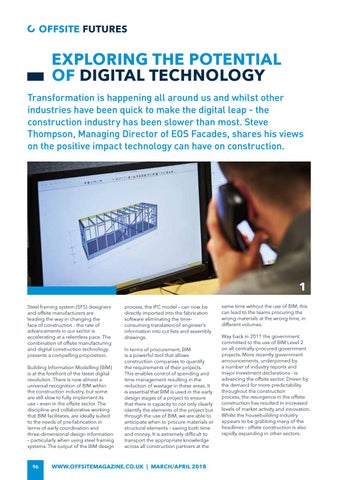OFFSITE FUTURES
EXPLORING THE POTENTIAL OF DIGITAL TECHNOLOGY Transformation is happening all around us and whilst other industries have been quick to make the digital leap - the construction industry has been slower than most. Steve Thompson, Managing Director of EOS Facades, shares his views on the positive impact technology can have on construction.
1 Steel framing system (SFS) designers and offsite manufacturers are leading the way in changing the face of construction - the rate of advancements in our sector is accelerating at a relentless pace. The combination of offsite manufacturing and digital construction technology presents a compelling proposition. Building Information Modelling (BIM) is at the forefront of the latest digital revolution. There is now almost a universal recognition of BIM within the construction industry, but some are still slow to fully implement its use – even in the offsite sector. The discipline and collaborative working that BIM facilitates, are ideally suited to the needs of pre-fabrication in terms of early coordination and three-dimensional design information – particularly when using steel framing systems. The output of the BIM design
96
process, the IFC model – can now be directly imported into the fabrication software eliminating the timeconsuming translation of engineer’s information into cut lists and assembly drawings. In terms of procurement, BIM is a powerful tool that allows construction companies to quantify the requirements of their projects. This enables control of spending and time management resulting in the reduction of wastage in these areas. It is essential that BIM is used in the early design stages of a project to ensure that there is capacity to not only clearly identify the elements of the project but through the use of BIM, we are able to anticipate when to procure materials or structural elements – saving both time and money. It is extremely difficult to transport the appropriate knowledge across all construction partners at the
WWW.OFFSITEMAGAZINE.CO.UK | MARCH/APRIL 2018
same time without the use of BIM, this can lead to the teams procuring the wrong materials at the wrong time, in different volumes. Way back in 2011 the government committed to the use of BIM Level 2 on all centrally-procured government projects. More recently government announcements, underpinned by a number of industry reports and major investment declarations - is advancing the offsite sector. Driven by the demand for more predictability throughout the construction process, the resurgence in the offsite construction has resulted in increased levels of market activity and innovation. Whilst the housebuilding industry appears to be grabbing many of the headlines - offsite construction is also rapidly expanding in other sectors.
